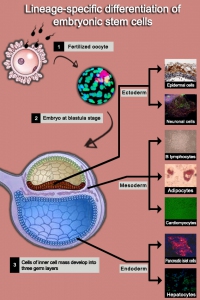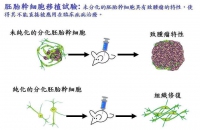In the pursuit of surface glycosphingolipids (GSLs) markers during the lineage-specific differentiation of human embryonic stem cells (hESCs), the team led by Dr. John Yu has made another major discovery of specific GSLs associated with differentiations of early embryonic cells toward specific progenitors of neural or endodermal cell types.
Cell surface GSLs, are ubiquitous components of cell membranes of animal cells that can act as mediators of cell adhesion and signal transduction and possibly be used as cell type-specific markers. Yu’s group had previously identified a group of surface GSLs to be useful in characterizing embryonic and induced pluripotent stem cells (iPS) as well as in serving as targets for cancer therapeutics.(See prior report)
 Recently, the team took another step to study the whereabouts of GSLs during the early lineage-specific differentiation of hESCs. To be more specific, according to Dr. Chia-Ning Shen, hESCs are derived from the inner cell mass of early embryos prior to implantation; after implantation, gastrulation occurs in which three germ layers of cells are formed within the embryos that will eventually evolve into specific mature tissues in an organism. For example, the outside germ layer (ecdoderm) cells develop into cells for neural or skin tissues, the middle germ layer(mesoderm) cells evolve into cells for muscles and bones, and the inner germ layer (endoderm) will form cells of digestive organs such as liver, pancreas and stomach.
Recently, the team took another step to study the whereabouts of GSLs during the early lineage-specific differentiation of hESCs. To be more specific, according to Dr. Chia-Ning Shen, hESCs are derived from the inner cell mass of early embryos prior to implantation; after implantation, gastrulation occurs in which three germ layers of cells are formed within the embryos that will eventually evolve into specific mature tissues in an organism. For example, the outside germ layer (ecdoderm) cells develop into cells for neural or skin tissues, the middle germ layer(mesoderm) cells evolve into cells for muscles and bones, and the inner germ layer (endoderm) will form cells of digestive organs such as liver, pancreas and stomach.
In order to determine changes in GSL compositions during lineage-specific differentiation of embryonic cells, researchers from Drs. John Yu’s and Chia-Ning Shen’s labs induced hESCs to differentiation, respectively, toward neural and definitive endodermal cells (precursor cells for liver and pancreas). Then, Dr. Kay-Hooi Khoo, adjunct Research Fellow of Genomics Research Center and Research Fellow at Institute of Biological Chemistry made an extensive and systematic analysis by using MALDI-MS, MS/MS mass spectrometry technology.
 It was found that during differentiation into neural progenitor cells, the core structures of GSLs in hESCs switched to mostly ganglio-series dominated by GD3. On the other hand, when hESCs differentiated into endodermal cells, patterns of GSLs diverged from those observed in embryonic body outgrowth or neural progenitors. The most prominent GSL identified in endodermal cells was Gb4Cer, without any appreciable amount of SSEA-3 and 4 antigens, nor GD3.
It was found that during differentiation into neural progenitor cells, the core structures of GSLs in hESCs switched to mostly ganglio-series dominated by GD3. On the other hand, when hESCs differentiated into endodermal cells, patterns of GSLs diverged from those observed in embryonic body outgrowth or neural progenitors. The most prominent GSL identified in endodermal cells was Gb4Cer, without any appreciable amount of SSEA-3 and 4 antigens, nor GD3.
The team also demonstrated that such a switch in GSL profiling was attributable to altered expression of key glycosyltransferases in the biosynthetic pathways, suggesting a close association of GSLs with lineage specificity and differentiation of hESCs. This is a pioneering work that pinpoints the specific GSL changes corresponding to targeted cell fate specification of lineages.
According to Dr. John Yu, current studies in stem cell research relies heavily on the use of monoclonal antibodies which recognize glycan epitopes; however, these epitopes were present in various glycoconjugates. As a result, the inherent cross-reactivities of antibodies to GSLs makes it difficult to ascertain the exact entities of GSLs on specific type of stem cells using these antibodies.
In other words, positive immunostaining with monoclonal antibodies alone may not reflect a particular entity of GSLs on stem cells. Instead, a detailed mass spectrometric analyses coupled with immunostaining will be essential to decipher the precise profile of GSLs in stem cells or cancer cells., This collaborative teamwork not only helps to resolve the mystery of GSLs during differentiation of hESCs, but also to establish a complete databank that will serve as a guide for future stem cell researches and pave the way for developing new strategy for cancer diagnosis and detection.
Details of the publication can be found online on Stem Cell website.